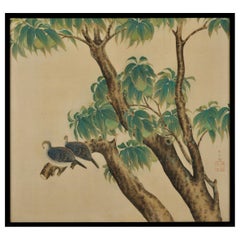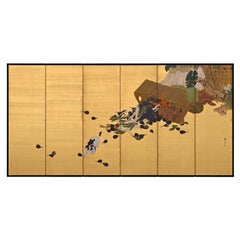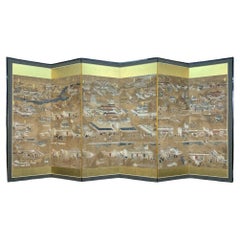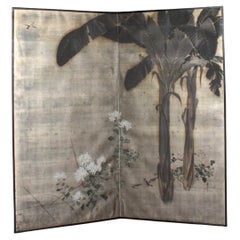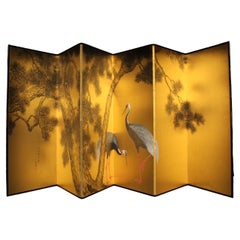Asia - Paintings and Screens
to
3
328
1,084
447
232
94
2
30
9
1
1
45
80
107
96
39
19
12
2
2
9
2
6
9
6
3
155
151
112
104
89
311
283
237
40
12
328
288
302
29
4
3
2
1
Item Ships From: Asia
Japanese Framed Silk Painting, Turtledoves and Peaches, Taisho Era, circa 1920
Located in Kyoto, JP
Nakamura Daizaburo
Turtledoves in a Peach Tree
Taisho period, circa 1920
Framed painting. Mineral pigments, ink and gofun on silk
Signed: Daizaburo
Dimensions (framed)...
Category
1910s Japanese Taisho Vintage Asia - Paintings and Screens
Materials
Wood, Silk
Circa 1920 Japanese Screen. Cat & Mouse Harvest Scene on Gold Silk.
Located in Kyoto, JP
The narrative playfulness of the scene depicted on this Japanese screen sets alight what is at its core a celebration of a bountiful harvest. The screen offers a visual representatio...
Category
Early 20th Century Japanese Taisho Asia - Paintings and Screens
Materials
Gold
Edo Period Kyoto Screen
Located in Fukuoka, JP
Edo Period Kyoto Screen
Period: Edo period
Size: 343 x 176 cm (134.6 x 69 inches)
SKU: RJ69
This stunning Edo period screen depicts typical scenes of d...
Category
18th Century Japanese Edo Antique Asia - Paintings and Screens
Materials
Silk, Wood, Paper
$9,450
Japanese Antiques 2panels, Silver back, Banana Plants, Rofuu folding Screen
Located in Niiza, JP
Material: Silver paper, wooden frame
One sheet: W870×H1740mm, unfolded size: W1740mm, 5kg
Folded size: W870×H1740×D35mm
Estimated packaging (sandwiched with 5-10mm plywood): 12cm x 1...
Category
19th Century Japanese Antique Asia - Paintings and Screens
Materials
Paper
Japanese Antiques 6panels, Gold back, crane and pine, Araki Jippo folding screen
Located in Niiza, JP
Material: gold background paper, wooden frame
One piece: W730 x H1760 mm, unfolded size: W4420 mm, 13 kg
Folded size: W750 x H1760 x D100 mm
Estimated packaging (sandwiched with 5 mm...
Category
Early 20th Century Japanese Asia - Paintings and Screens
Materials
Paper
Evolving Elegance: An Oxidized Silver Screen from the Meiji Period
Located in Fukuoka, JP
This anodized 6-panel screen captures the serene and minimalistic beauty of a bamboo grove, embodying the aesthetic principles of the Edo period. The screen features subtle and delic...
Category
18th Century Japanese Edo Antique Asia - Paintings and Screens
Materials
Silver Leaf
B10 Japanese Antiques 6panels, Paper, folding Screen with Flower & bird painting
Located in Niiza, JP
Flower and bird painting
Material: Paper on wooden frame, colored
One piece: W660×H1825mm×D20mm,
Unfolded size: W3860mm, 16kg
Folded size: W660×H1825×D110mm
Packaging (sandwiched wit...
Category
19th Century Japanese Antique Asia - Paintings and Screens
Materials
Paper
Korean Chaekgeori painting. 19th Century Joseon. Books & Scholars’ Accouterments
Located in Kyoto, JP
Books and Scholars’ Accouterments; Chaekgeori
Second half of the 19th century
Korean framed panel. Ink and color on paper.
This Korean Chaekgeori...
Category
Late 19th Century Korean Edo Antique Asia - Paintings and Screens
Materials
Paper
B22 Japanese Antiques 6panels, Silver Paper, folding Screen
Located in Niiza, JP
Silver foil folding screen
Material: Paper pasted on wooden frame
1 piece: Width 595 x Height 1740 x Depth 18 mm
Expanded size: Width 3610 mm
Folded size: Width 615 x Height 1740 x D...
Category
20th Century Japanese Asia - Paintings and Screens
Materials
Paper
Peacock Chinoiserie Wallpaper Hand Painted Wallpaper on Champagne Metallic
Located in Wuxi, 32
If you love the look of De Gournay wallpaper but not the price, this is for you. Measures: 36" wide x 91" height
The colorways in this sections present our latest colorways, which c...
Category
21st Century and Contemporary Chinese Asia - Paintings and Screens
Materials
Gold Leaf
Japanese Painting, Hanging Scroll, Mid 19th Century, Koi and Water Plants
By Iwase Hirotaka
Located in Kyoto, JP
Iwase Hirotaka (1808-1877)
Koi and Water Plants
Hanging scroll, ink, color, gold wash and gold flecks on silk
Inscription: Hirotaka
Seal: Ille...
Category
1860s Japanese Edo Antique Asia - Paintings and Screens
Materials
Silk
Japanese Screen Painting, circa 1700 'Horses' by Kano Tanshin
Located in Kyoto, JP
Horses
Kano Tanshin Morimasa (1653-1718)
Two-panel tea-ceremony Japanese screen or furosaki
Ink on gold leaf,
late 17th-early 18th century
Measures: H 55 cm x W 182 cm
The Kano school was closely aligned with the warrior class in Japan. The samurai, who lived in a closed and rigid hierarchical society established by the Shogunate, were drawn to the energy and freedom horses symbolize; Kano school artists commonly depicted the equine creatures as they are here, in unfettered and carefree family groups. China originally introduced horse paintings to Japan; the works typically focused on capturing the essence of horses in their various environments and often involved integrating human figures into the images.
Kano Tanshin Morimasa (1653-1718) was the son of Kano Tanyu...
Category
1690s Japanese Edo Antique Asia - Paintings and Screens
Materials
Gold Leaf
Meiji Period Silver Oxidized Screen
Located in Fukuoka, JP
Meiji Period Silver Oxidized Screen
Period: Meiji
Size: 174 x 174 cm (68.5 x 68.5 inches)
SKU: PTA107
Step back in time with this Meiji period screen, where the allure of silver ox...
Category
19th Century Japanese Meiji Antique Asia - Paintings and Screens
Materials
Silver Leaf
Japanese Painting, Framed Panel, Willow and Sparrows, circa 1920 Taisho era
Located in Kyoto, JP
Anonymous
Summer willow and sparrows
Taisho period, circa 1920
Framed painting. Mineral pigments, mica, gold, ink and gofun on silk
Dimensions (framed):
H. 98 cm x W. 135 cm x D...
Category
1920s Japanese Taisho Vintage Asia - Paintings and Screens
Materials
Wood, Silk
Chinoiserie Wallpaper Hand Painted Wallpaper on Silk, Accept Custom Size
Located in Wuxi, 32
If you love the look of De Gournay wallpaper but not the price, this is for you. Measures: 3ft W x 8ft H.
The colorways in this sections present our latest colorways, which can be...
Category
21st Century and Contemporary Chinese Asia - Paintings and Screens
Materials
Silk
Late 17th Century Japanese Screen. Puppy and Kittens on Gold Leaf.
Located in Kyoto, JP
Anonymous
Late 17th century
Puppy & Kittens
A six-panel Japanese screen. Ink, color, gofun, gold-leaf and gold-fleck on paper.
A medium sized late 17th century Japanese screen fe...
Category
Late 17th Century Japanese Edo Antique Asia - Paintings and Screens
Materials
Gold Leaf
B41 Japanese Antiques 6panels, Silver Paper, folding Screen, brown-rimmed
Located in Niiza, JP
Material: Paper, wooden frame
1 piece: Width 435 x Height 1370 x Depth 18 mm
Expanded size: Width 2650 mm
Folded size: Width 455 x Height 1370 x Depth 100 mm, weight 9 kg
Packaging (...
Category
20th Century Japanese Asia - Paintings and Screens
Materials
Paper
Japanese Painting, Framed Panel, Dahlias and Roosters, circa 1920
Located in Kyoto, JP
Tanaka Tessen (b.1890)
Dahlias and Roosters
Taisho period, circa 1920
Framed painting. Mineral pigments and ink on silk.
Dimensions (framed):
H. 159 cm x W. 97 cm x D. 2.5 cm (62.5” x 38” x 1”)
An ornate and complex composition in which the artist explores almost the entire painting surface. The coloration is bold and evocative and the tinted silk ground recreates the warm golden glow of sunset. Soft, luminous brushwork details the black feathers of the roosters, which seem to cloud and blur in counterpoint to the sharper points of the eyes and beaks. Their brilliant red combs balance the composition, echoing the rich burgundy hues of the dahlias; the flowers exquisite and lifelike. Dahlias were an exotic subject favored by painters of the Taisho era.
The painting belongs to the school of Kyoto Nihonga, exemplifying the principles of decorative elegance and consumate brush technique with which it was intimately associated. Painters of the time relied on the Shijo school method, basing the forms of the composition from life sketches. Sometimes they were then integrated with elements derived from Chinese bird and flower...
Category
1920s Japanese Taisho Vintage Asia - Paintings and Screens
Materials
Wood, Silk
19th Century Japanese Screen for Tea-Ceremony, Ink Bamboo and Plum on Gold Leaf
Located in Kyoto, JP
Three Friends of Winter
Nakajima Raisho (1796-1871)
Late Edo period, circa 1850
Ink and gold leaf on paper.
This is a double-sided Japanese Furosaki or tea-ceremony screen from the mid 19th century; bamboo and plum on the front, young pines the back. It by Nakajima Raisho, a master painter of the Maruyama school in the late Edo and early Meiji periods. In this work Raisho combines exquisite ink brushwork with large open spaces of brilliant gold-leaf to inspire the viewers imagination. Rather than naturalism, he is searching for the phycological impression of the motifs, resulting in abstraction and stylization. His simplification of the motifs the result of looking to capture the inner nature of the objects. This art motif is known as Sho Chiku Bai, or the Three Friends of Winter. Evergreen pine connotes steadfastness, bamboo suggests both strength and flexibility, while plum blossoms unfurling on snow-laden branches imply hardiness. Combined, this trio is emblematic of Japanese new year. Chinese literati were the first to group the three plants together due to their noble characteristics. Like these resilient plants flowering so beautifully in winter, it was expected of the scholar-gentleman to cultivate a strong character with which he would be able to show the same degree of perseverance and steadfastness even during times of adverse conditions.
The screen would have been placed near the hearth of a room used for the Japanese tea ceremony, shielding the fire from draughts and also forming a stimulating and decorative backdrop behind the tea utensils. It would have been used in the Hatsugama, or first tea-ceremony of the new year.
Nakajima Raisho (1796-1871) originally studied under Watanabe Nangaku before entering the school of Maruyama Ozui. He was the highest ranking Maruyama school painter at the end of the Edo period and was known as one of the ‘Four Heian Families’ along with Kishi...
Category
Mid-19th Century Japanese Edo Antique Asia - Paintings and Screens
Materials
Gold Leaf
B9 Japanese Antiques Silver folding screen, 2panel
Located in Niiza, JP
Unfolded size: 1700 x 1700 x 20 mm
Foldable: 850 x 1700 x 40 mm, 7kg
Estimated size after packaging (sandwiched between 5-10 mm plywood):
10 cm x 92 cm x 182 cm Weight 30 KG
A bea...
Category
20th Century Japanese Asia - Paintings and Screens
Materials
Paper
Japanese Painting, 17th Century, Tale of Genji, Tosa School
Located in Kyoto, JP
Illustration to an unidentified chapter of the Tale of Genji (Genji Monogatari)
Tosa School (second half of the 17th Century)
Ink, pigment, gofun and...
Category
Late 17th Century Japanese Edo Antique Asia - Paintings and Screens
Materials
Gold Leaf
17th Century Japanese Screen Pair by Soga Nichokuan, Hawks on Pine & Plum Trees
Located in Kyoto, JP
Hawks on plum and pine
Soga Nichokuan (active circa 1625-1660)
Pair of six-fold screens.
Ink, mineral pigments, gofun, gold and speckled gold l...
Category
1640s Japanese Edo Antique Asia - Paintings and Screens
Materials
Wood, Paper
Pink Floral Wallpaper Hand Painted Wallpaper on White Silk / Roll
Located in Wuxi, 32
If you love the look of De Gournay wallpaper but not the price, this is for you. Measures: 3 ft x 8 ft.
The colorways in this sections present our latest colorways, which can be app...
Category
21st Century and Contemporary Chinese Asia - Paintings and Screens
Materials
Silver Leaf
Palm Tree Chinoiserie Wallpaper Hand Painted Wallpaper on Blue EDO Panel
Located in Wuxi, 32
If you love the look of De Gournay wallpaper but not the price, this is for you.
The colorways in this sections present our latest colorways, which can be applied to any designs and any base ground (silk, tea paper, metallic, fabric and etc.)
Price
There are 6 panels in the listed photo, price is for 1 panel of 36" wide x 96" high, background is on EDO silk...
Category
21st Century and Contemporary Chinese Asia - Paintings and Screens
Materials
Silk
Mid 19th Century Framed Japanese Painting. Snail, Wasp & Hollyhock.
Located in Kyoto, JP
Obata Tosho (1812-1886)
Snail, Wasp & Hollyhock
Late Edo period, mid 19th Century
Framed Japanese Painting. Ink and color on paper.
Individually framed 19th century bird and flow...
Category
Mid-19th Century Japanese Edo Antique Asia - Paintings and Screens
Materials
Paper
B31 Japanese Antiques 2panels, paper, folding Screen with flower
Located in Niiza, JP
Material: paper on wooden frame
One piece: W755×H1520mm×D15mm,
Unfolded size: W1510mm
Folded size: W755×H1520×D30mm, 5kg
Packaging (sandwiched with 5-10mm plywood): 15cm x 86cm x 16...
Category
19th Century Japanese Antique Asia - Paintings and Screens
Materials
Paper
Japanese Screen Pair, circa 1730, Peacocks and Phoenix, Kano School
Located in Kyoto, JP
Phoenix and Peacocks.
A pair of six-panel Japanese folding screens by Tsunetake Yotei (n.d.)
First half of the 18th century.
The signature reads 67 year old Tsunetake.
The seals read:
-Tsunetake no in,
-Yotei,
-Seishin
Dimensions:
Each screen – H. 69” x W. 149” (176 cm x 378 cm)
A pair of Kano Grand Picture (Waga) screens depicting phoenix and peacocks rich with symbolic meaning. Dating to the first half of the 18th century, from the Kobikicho Kano school in Edo, this pair of folding...
Category
Early 18th Century Asian Edo Antique Asia - Paintings and Screens
Materials
Gold Leaf
JapaneseAntiques Terasaki kogyo, Gold background, Bamboo and plum folding screen
Located in Niiza, JP
material: paper and cloth
Unfolded size: 1600 x 1660 mm
Can be folded in half: 800 x 1660 mm, 6 kg
Estimated packing size: (Sandwich with 12mm plywood)
10 × 95 × 185cm 30kg
A bold ...
Category
20th Century Asia - Paintings and Screens
Materials
Paper
Bali Hindu Textile Framed 'Kamasan' Painting, Indonesia C. 1950
Located in Jimbaran, Bali
A mid-20th century 'Kamasan' cotton textile painting from Bali, Indonesia. The hand-painted image has great detail and depicts Balinese Hindu mythology. Key features of this image ar...
Category
1950s Balinese Folk Art Vintage Asia - Paintings and Screens
Materials
Cotton, Paint
The Plovers over the Sea Shores Screen
Located in Fukuoka, JP
The Plovers over the Sea Shores Screen
Period: 18th century (Edo period)
Size: 360 x 170 cm (141.7 x 66.9 inches)
SKU: PA39
Travel back in time with this classic Edo period screen,...
Category
18th Century Japanese Edo Antique Asia - Paintings and Screens
Materials
Wood, Paper
Mountain Mural Hand Painted Wallpaper on Silk Panel, Accept Custom Size
Located in Wuxi, 32
If you love the look of De Gournay wallpaper but not the price, this is for you.
The colorways in this sections present our latest colorways, which can be applied to any designs a...
Category
21st Century and Contemporary Chinese Asia - Paintings and Screens
Materials
Silk
B20 Japanese Antiques 2panels, Paper, folding Screen with Pine Tree and Crane
Located in Niiza, JP
Pine Trees and Cranes
Materials: Paper on Wooden Frame, Colored
One piece: W865×H1760mm,
unfolded size: W1730mm, 6kg
Folded size: W865×H1760×D35mm
packaging estimate (sandwiched with...
Category
Early 20th Century Japanese Asia - Paintings and Screens
Materials
Paper
Mid 19th Century Framed Japanese Painting. Spider & Morning Glory.
Located in Kyoto, JP
Obata Tosho (1812-1886)
Spider & Morning Glory
Late Edo period, mid 19th Century
Framed Japanese Painting. Ink and color on paper.
Individually framed 19th century bird and flowe...
Category
Mid-19th Century Japanese Edo Antique Asia - Paintings and Screens
Materials
Paper
Edo Period (19th) Japanese antique painting of flowers
Located in Fukuoka, JP
Japanese antique painting of flowers 19 C
Weight 3kg ( 6.6lb)
Category
Mid-19th Century Japanese Edo Antique Asia - Paintings and Screens
Materials
Silk, Paper
Early 20th Century Japanese Nihonga Scroll. Crow & Persimmon.
Located in Kyoto, JP
Anonymous.
Crows & Persimmon
Japanese Scroll. Pigments and Ink on Silk.
Dimensions:
Scroll: H. 235 cm x W. 106 cm.
Image: H. 168 cm x W. 86 cm.
Bird and flower paintings are oft...
Category
Early 20th Century Japanese Taisho Asia - Paintings and Screens
Materials
Silk
B20 Japanese Antiques 6panels, Silver Paper, folding Screen
Located in Niiza, JP
Silver-covered folding screen
Material: Paper on wooden frame
One piece: W600×H1745mm×D20mm,
Unfolded size: W3630mm
Folded size: W615×H1745×D105mm, 12kg
Packaging (sandwiched with 5m...
Category
20th Century Japanese Asia - Paintings and Screens
Materials
Paper
Japanese Painting, Hanging Scroll, 19th Century Bamboo in Moonlight
Located in Kyoto, JP
Bamboo in moonlight
Gamo Rakan (1784-1866)
Hanging scroll, ink on silk.
Dimensions:
Scroll: 201 cm x 58 cm
Image: 137 cm x 45 cm
In this early 19th century work by Gamo Rakan a light ink wash applied to the silk background silhouettes the moon and suggests the atmosphere of early evening. Even though it is a literati subject, Rakan’s bamboo is quite realistic with a strong decorative style. The painting finds its inspiration from Chinese Ming dynasty painters who often used a single-tone, jet black stroke to emphasize the calligraphic nature of bamboo.
In a different era, decorative would have been seen as somewhat unrefined. But increasingly in the Edo period, it was the hallmark of high style. The Japanese people, in particular the rising merchant class, had gradually become apathetic toward the traditional Sesshu and Kano schools of painting. Chinese professional and amateur painters living in the port of Nagasaki during the 18th century had a profound effect on Japanese painting and the freshness of their style and its decorative appeal contributed greatly to its popularity. Gamo Rakan’s teacher, Tani Buncho...
Category
Early 19th Century Japanese Edo Antique Asia - Paintings and Screens
Materials
Silk
Panoramic Wallpaper Hand Painted Wallpaper on Scenic Paper, Accept Custom Size
Located in Wuxi, 32
If you love the look of De Gournay wallpaper but not the price, this is for you. Measures: 36" Wide x 96" Height
The colorways in this sections present our latest colorways, which can be applied to any designs and any base ground (silk, tea paper, metallic, fabric and etc.)
Price
There are 5 panels in the listed photo, price is for 1 panel of 36" wide x 96" high, background is on Scenic paper. We accept custom size and painting colors.
Dear customer, please note:
For safe delivery, all the panels roll in a strong tube.
Please have the professional installer to install the wallpapers, there is a standard overlap between panels, and a black dot marked on the top and bottom of each panel, please check well before installing.
Shipping
We do our best to process & ship all orders...
Category
21st Century and Contemporary Chinese Asia - Paintings and Screens
Materials
Paper
Chinoiserie Panel Hand Painted Wallpaper on Green silk, Accept Custom Size
Located in Wuxi, 32
If you love the look of De Gournay wallpaper but not the price, this is for you. Measures: 36" W x 72" H.
The colorways in this sections present our latest colorways, which can be...
Category
21st Century and Contemporary Chinese Asia - Paintings and Screens
Materials
Silk
B7 Japanese Antiques Silver Screen, 6-panel Byobu
Located in Niiza, JP
Size when unfolded: 3480 x 1180 x 15 mm
Can be folded to 580 x 1180 x 105 mm. 7㎏
Estimated size after packaging (sandwiched between 5 mm plywood):
22 CM x 70 CM x 130 CM Weight 22 K...
Category
20th Century Japanese Asia - Paintings and Screens
Materials
Paper
Korean Painting, Wall Panel, 17th Century Ink Grapevine
Located in Kyoto, JP
Grapevine
Anonymous. Korean, 17th century.
Wall panel, ink on paper.
Upper seal:
Kou Kinun in
Lower seal:
Kaigen
Dimensions:
Measures: 98.5 cm x 29.5 cm (39” ...
Category
17th Century Korean Other Antique Asia - Paintings and Screens
Materials
Wood, Paper
17th century Japanese Falcon Painting, Mitani Toshuku, Unkoku School
By Mitani Toshuku
Located in Kyoto, JP
Mitani Toshuku (1577-1654)
“Falcon”
Wall panel, ink and light color on paper.
Upper Seal: Mitani
Lower Seal: Toshuku
Dimensions:
Each 118.5 cm x 51 cm x 2 cm (46.5” x 20” x .75”)
Individual falcon paintings by Mitani Toshuku (1577-1654), an early artist of the Unkoku School. Founded by Unkoku Togan (1547–1618), a master of the Momoyama period, the Unkoku school enjoyed long lasting patronage in southern Japan. Togan was a retainer of the Mori family in present day Yamaguchi prefecture. Members of the school considered themselves to be in the artistic lineage of Sesshu Toyo...
Category
Early 17th Century Japanese Edo Antique Asia - Paintings and Screens
Materials
Paper
17th Century Japanese Screen. Ink Plum Tree & Birds by Kano Naonobu.
Located in Kyoto, JP
Kano Naonobu (1607-1650)
Plum Tree and Birds
Six-fold Japanese Screen. Ink and slight color on paper.
In this evocative ink work spread over a six-panel folding screen, we see the consummation of the elegance and refinement of the Edo Kano school. This 17th century screen is a rare surviving example of a large-scale bird and flower painting by Kano Naonobu, the younger brother of Kano Tanyu...
Category
17th Century Japanese Edo Antique Asia - Paintings and Screens
Materials
Wood, Paper
Art Deco Garden Screen 3 Panels By André Fu Living
By André Fu
Located in Admiralty, HK
designed as a nod to the beauty of japanese zen gardens, this artfully designed movable screen is visually pure in its composition, yet intricate at the same time. crafted in solid a...
Category
2010s Chinese Modern Asia - Paintings and Screens
Materials
Ash
$15,455 / item
The sky visible at Honmonji TempleⅣ by Blue Tip Atelier
Located in Sammu-shi, Chiba
Title : The sky visible at Honmonji TemplⅣ
Japan / 2024s
Size : W 275 H 395mm
A mini series of the sky as seen from Honmonji Temple.
Natural dyes used are Indian madder and oak g...
Category
2010s Japanese Modern Asia - Paintings and Screens
Materials
Linen
ICHIMATSU by Blue Tip atelier
Located in Sammu-shi, Chiba
Title : ICHIMATSU
Japan / 2020s
Size : W 1480 x H 1480 mm
Each part is dyed with indigo to express a checkered pattern that collapses. This quilt is made with Woven fresh linen. Hand-quilted with cotton thread. Hand dyed with indigo.
[Blue Tip atelier...
Category
2010s Japanese Modern Asia - Paintings and Screens
Materials
Linen
The Plovers over the Sea Shores Screen (2/2)
Located in Fukuoka, JP
The Plovers over the Sea Shores Screen
Period: 18th century (Edo period)
Size: 360 x 170 cm (141.7 x 66.9 inches)
SKU: PA39
Travel back in time with this classic Edo period screen,...
Category
18th Century Japanese Edo Antique Asia - Paintings and Screens
Materials
Wood, Paper
B12 Japanese Antiques 6panels, Silver Paper, folding Screen
Located in Niiza, JP
Silver-covered folding screen
Material: Paper on wooden frame
One piece: W600×H1745mm×D20mm,
Unfolded size: W3630mm
Folded size: W615×H1745×D105mm, 12kg
Packaging (sandwiched with 5m...
Category
20th Century Japanese Asia - Paintings and Screens
Materials
Paper
Japanese Painting, Hanging Scroll, 'Playful Cat' by Hirose Toho, 1920s Taisho
By Hirose Toho
Located in Kyoto, JP
Playful Cat
Hirose Toho (1875-1930)
Hanging scroll, ink, mineral pigments and gofun on silk.
Painting inscription: Toho Sha
Painting seals:
Upper - Hirose Hitoshi
Lo...
Category
1920s Japanese Taisho Vintage Asia - Paintings and Screens
Materials
Silk
Japanese Contemporary Brocade Silk Handcrafted Framed Oshie Decorative Art
Located in Takarazuka, JP
Exquisite Japanese contemporary framed oshie wall decorative art piece, recreating a famous painting from Meiji period featuring a Japanese dancer holding a net with cherry blossom ...
Category
21st Century and Contemporary Japanese Meiji Asia - Paintings and Screens
Materials
Brocade, Silk
17th Century Korean Grapevine and Squirrel Scroll Painting, Mid Joseon Period
Located in Kyoto, JP
Anonymous. Korean, 17th century. Joseon period.
Hanging scroll. Ink on paper.
Seal: Shinso
Dimensions:
Scroll: H. 200 cm x W. 31 cm (79” x 12”)
Image: H. 122 cm x W. 29.5 cm (48” x 11.5”)
The grapevine came to China and then Korea from western Asia via the silk road trade routes. By the mid-Joseon period, it was one of the most popular subjects for Korean literati painters. Grapevines were painted as a singular subject or, less commonly, in combination with squirrels, which are associated with children due to their playful nature. Together, grapevines and squirrels embody wishes for abundant offspring and wealth.
For the Korean literati artist the twisting vines, curling tendrils and round, plump grapes provided ample opportunity for expressive "brush play”. In this painting the artist has abstracted the scene and is seemingly unconcerned with discontinuities and proportion. Vines spring up from nowhere, grapes hang in random clusters and the squirrel’s head appears as if twisted backwards. For the vines and leaves we can feel a sense of speed in the brushstrokes, imparting a dynamic feel which is at once intense and animated. This contrasts dramatically with the countless tiny strokes of ink which realistically capture the texture of the squirrel’s fur...
Category
17th Century Korean Other Antique Asia - Paintings and Screens
Materials
Paper
Early View of India, Panoramic Mural Hand Painted Wallpaper on Scenic Paper
Located in Wuxi, 32
If you love the look of De Gournay wallpaper but not the price, this is for you.
The colorways in this sections present our latest colorways, which can be applied to any designs a...
Category
21st Century and Contemporary Chinese Asia - Paintings and Screens
Materials
Paper
B11 Japanese Antiques 6panels, Paper, folding Screen with Flower & bird painting
Located in Niiza, JP
Bird and flower painting
Material: Paper on wooden frame, colored
One piece: W660×H1825mm×D20mm,
Unfolded size: W3860mm, 16kg
Folded size: W660×H1825×D110mm
Packaging (sandwiched wit...
Category
19th Century Japanese Antique Asia - Paintings and Screens
Materials
Paper
Japanese Silver Screen Pair, Meiji Period, Herons & Plovers, Shijo School
Located in Kyoto, JP
Heron & Plovers
Ink and silver leaf on paper
Maekawa Bunrei (1837-1917)
A pair of low six-panel Japanese screens by Maekawa Bunrei, a later master of the Kyoto based Shijo school of painting. On the right screen a solitary white heron stands motionless in a stream. On the left screen plovers play along a shoreline. The elegant forms are executed employing fluid, minimalistic ink brushstrokes. The soft brushstrokes and the sharp light of the silver leaf lend the scenes a sense of translucence. The sophisticated composition superbly exploits the long, horizontal pictorial surface of the pair of folding screens...
Category
Early 1900s Japanese Meiji Antique Asia - Paintings and Screens
Materials
Silver Leaf
Japanese Contemporary Black Gold Silk Brocade Two-Panel Folding Screen
Located in Takarazuka, JP
Exceptional Japanese contemporary two-panel "byobu" or folding screen featuring two graceful ladies dressed in elegant formal traditional Japanese kimonos. This folding screen is ins...
Category
21st Century and Contemporary Japanese Meiji Asia - Paintings and Screens
Materials
Gold
19th Century Japanese Scroll Painting by Igarashi Chikusa, Poppies & Butterflies
Located in Kyoto, JP
Poppies & Butterflies
Ink, pigment and gofun on silk
Igarashi Chikusa (1774-1844)
Signature: Chikusa Ran Zen
Upper Seal: Ran Shuzen
Lower Seal: Kyoho
Dimensions:
Scroll: H. 68” x W. 18” (172cm x 45cm)
Image: H. 38.5’’ x W. 12.5’’ (98cm x 32cm)
This composition shows elegant images of poppies and the butterflies that are inevitably drawn to them. It captures a momentary glimpse into a world both visually dazzling and startlingly realistic. The painting is infused with sensitivity and attention to seasonal change and weather conditions. The thin and fragile poppies are beautifully depicted with brilliant colors and the butterflies are similarly infused with life. The painting is on silk which requires extremely precise painting skills as no element once painted can be removed.
Poppies were a favorite subject of Rinpa school artists through the ages. Originally they were somewhat abstracted but by the age of Sakai Hoitsu...
Category
Early 19th Century Japanese Edo Antique Asia - Paintings and Screens
Materials
Silk
17th Century Japanese Screen. Karako Asobi: Chinese Children at Play.
Located in Kyoto, JP
Anonymous Kano school artist
17th century
"Karako Asobi: Chinese Children at Play"
A two-panel Japanese Furosaki screen. Ink, pigment, gofun and gold-leaf on paper.
This small Japanese Karako folding screen vividly depicts various games played by children wearing wearing elaborate Chinese T'ang dynasty costumes. They are dressed in plumed and tasseled hats, ornate jackets, baggy pants, and cloth slippers typical of T'ang period Chinese court dress. The children are depicted pulling a younger child along in a cart, carrying another child as if an important official, riding a wooden horse, leading a puppy and carrying a tethered bird. Executed in fine-quality pigments on gold leaf, the detail, variety and size of the figures is noteworthy. Also notable is the size of this screen itself, which denotes it as a Furosaki screen. A Furosaki screen is part of the equipment used for the Japanese tea-ceremony. It is traditionally placed on tatami mats behind the brazier highlighting the utensils and providing a focal point.
Karako is a Japanese term used in art with the depiction of Chinese children playing...
Category
17th Century Edo Antique Asia - Paintings and Screens
Materials
Gold Leaf
Wisteria Wallpaper Hand Painted Wallpaper on Gray Silk- Accept Custom Size
Located in Wuxi, 32
If you love the look of De Gournay wallpaper but not the price, this is for you. Measures: 42"W x 81" H.
The colorways in this sections present our latest colorways, which can be ...
Category
21st Century and Contemporary Chinese Asia - Paintings and Screens
Materials
Silk
Bali Hindu Textile Framed 'Kamasan' Painting, Indonesia C. 1950
Located in Jimbaran, Bali
This striking vintage Balinese Kamasan painting, rendered on handwoven cotton, beautifully captures the timeless elegance of classical Wayang-style st...
Category
1950s Balinese Folk Art Vintage Asia - Paintings and Screens
Materials
Cotton, Paint
Japanese Scroll Painting, 19th Century Chinese Pheasants by Yoshizawa Setsuan
Located in Kyoto, JP
Chinese Pheasants
Yoshizawa Setsuan (1809-1889)
Hanging scroll, ink and color on silk.
Painting inscription: Setsuan Houyou
Upper seal: Y...
Category
Mid-19th Century Asian Meiji Antique Asia - Paintings and Screens
Materials
Silk
Recently Viewed
View AllMore Ways To Browse
Japanese Screen Sun
Horse Panel Screen
Japanese Scroll Cranes
Mughal Screen
Japanese Scroll Kano
Gold 6 Panel Screen
Meiji Books
Gold Leaf Cranes
Japanese Floor Screens
Japanese Horse Painting
Japanese Painted Screen Floral
Geisha Screen
Japanese Tiger Screen
Painted 4 Panel Screen Chinese
Japanese Rimpa Screens
Mughal Style Painting
Hunting Screen
Japanese Dragon Screen
